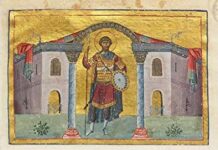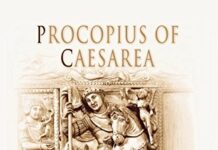
Ebook Info
- Published: 2015
- Number of pages: 312 pages
- Format: PDF
- File Size: 1.70 MB
- Authors: Anthony Kaldellis
Description
Although Byzantium is known to history as the Eastern Roman Empire, scholars have long claimed that this Greek Christian theocracy bore little resemblance to Rome. Here, in a revolutionary model of Byzantine politics and society, Anthony Kaldellis reconnects Byzantium to its Roman roots, arguing that from the fifth to the twelfth centuries CE the Eastern Roman Empire was essentially a republic, with power exercised on behalf of the people and sometimes by them too. The Byzantine Republic recovers for the historical record a less autocratic, more populist Byzantium whose Greek-speaking citizens considered themselves as fully Roman as their Latin-speaking “ancestors.”Kaldellis shows that the idea of Byzantium as a rigid imperial theocracy is a misleading construct of Western historians since the Enlightenment. With court proclamations often draped in Christian rhetoric, the notion of divine kingship emerged as a way to disguise the inherent vulnerability of each regime. The legitimacy of the emperors was not predicated on an absolute right to the throne but on the popularity of individual emperors, whose grip on power was tenuous despite the stability of the imperial institution itself. Kaldellis examines the overlooked Byzantine concept of the polity, along with the complex relationship of emperors to the law and the ways they bolstered their popular acceptance and avoided challenges. The rebellions that periodically rocked the empire were not aberrations, he shows, but an essential part of the functioning of the republican monarchy.
User’s Reviews
Editorial Reviews: Review “This is a path-breaking book that will change the discussion on the political structure of the later Roman Empire―Byzantium―and put it, finally, on a proper course.”―Dimitri Gutas, Yale University“This is an important book that establishes beyond a doubt that the image we have of Byzantium, the Roman Empire in the East, is in need of revision. Kaldellis breaks down the artificial and damaging divide between Roman and Byzantine studies with his encyclopedic knowledge of the full run of Byzantine historiography.”―Paul Stephenson, Radboud University Nijmegen, The Netherlands“Any student of political science will find this study of interest because of its discussions of both theory and specific historical documents…Byzantine specialists will find intriguing the author’s remarks about continuity, and nonspecialists will appreciate his discussion about the legitimacy of power in a medieval context.”―J. W. Nesbitt, Choice About the Author Anthony Kaldellis is Professor and Chair of the Department of Classics at The Ohio State University. He is the author of many books, including The Christian Parthenon, Hellenism in Byzantium, and The Byzantine Republic, which have been translated into French, Greek, and Russian.
Reviews from Amazon users which were colected at the time this book was published on the website:
⭐Historians usually describe the Byzantine empire as a theocracy governed by an emperor with unlimited powers who ruled by divine right. That description is incorrect, this book argues, both in terms of how Byzantine politics actually worked and how the Byzantines themselves saw things. It argues that while the emperor had extensive powers, those powers were understood to be granted by the people and could only be legitimately exercised on their behalf. In this sense, Byzantium was a (monarchical) “republic” in the classical sense, with roots extending back to the Roman Republic.It is important to understand is that this not a book about the history of the Byzantine Empire – it is about *how historians write about the Byzantine Empire*. So the reader who does not already have a good understanding of the chronology and structure of the empire will be lost. Moreover, a reader interested in the history itself – rather than the intellectual development of the field of Byzantine Studies – will find the book of limited interest.Overall, I found the basic argument convincing, and important on its own terms. Those who are steeped in Byzantine history will find the new perspective refreshing and, I suspect, persuasive. In terms of writing, the book is a bit tendentious, with more argumentation and repetition than necessary. I wish it had spent more time on the facts – chapter 5, which provides a huge amount of evidence that the people did indeed play a meaningful role in the selection and removal of emperors, is the highlight. The book is also marred by the occasional tendency to interject comments about modern American politics, such as that American democracy is not all that much more democratic than selection of emperors in Byzantium or that George W. Bush “in fact” lost the election of 2000, that are gratuitous distractions from an otherwise well-reasoned discussion.
⭐This book’s intriguing premise is that the Byzantine people had a level of influence over their rulers similar to that in the Roman republic. Too often, historians in the Byzantine field repeated the line that the emperor was second only to the apostles so people viewed him almost as holy. However, when reading through the history, that premise is hard to consider valid when seeing the many rebellions and overthrows of emperors that occurred throughout the 11 centuries it stood. What amazed me most was that it took so long for any historian to figure this out.This is an academic book written by an academic and can be a little challenging for the armchair historian to finish. The first three chapters were not an easy read. However, the next couple of chapters rewarded me with many great examples of how the Byzantine people made their pleasure or displeasure with an emperor known. Kaldellis’ reasoning neatly explained the many of the events I know of in the 10th and 11th century beyond what other historians have written. I especially appreciated his telling of the Arab or Persian ambassador to the court of Basil II, and Basil admitting to the diplomat that emperors only ruled as long as the people let him rule.I think this willingness to throw off incompetent emperors was one of the strengths of the Byzantine empire. There may have been dynasties, but each ruler came to the throne knowing he had to perform well on it, or they could end up dead or in a monastery.The last chapter on Byzantine faith seemed a little weak. The author again mentions what various contemporary Byzantine historians have written about the sanctity of the emperor, but doesn’t really address the fact that those writers would have been members of the elite, writing for the emperor’s favor. Of course they would say that. But it was often members of the populares, the common people, not the elite/optimates, who did the overthrowing. And even if they didn’t instigate the overthrow themselves, as the author often mentions, acceptance by the people was needed by any claimant.The author throws in the occasional reference to modern politics. This is jarring to the reader who is focused on Byzantine history, and unnecessary.Similar to reading Julius Caesar say “ok” in a historical novel.Overall, though, this book added a great deal of nuance to my understanding of Byzantine history. I love Byzantine history and the work of historians such as Kaldellis add greatly to our understanding of the empire. I just wish they would learn to tell the story of this dynamic civilization without so much academic jargon
⭐This is an excellent and scholarly work that puts the so-called “Byzantine” Empire into a clearer perspective. Kaldellis thesis essentially states that the emperors did not actually possess the “absolute” power we have traditionally assumed them to hold. Rather, a form of republicanism was still very much alive, and the emperors were subject to its . Kaldellis also approaches the empire as the continuation of the late Roman empire in the East, and not what many scholars of the period describe as a “Byzantine”- or even more misleading- “Greek” empire. (Consider that the common language of the United States is English. Should we consider ourselves to be “English” rather that American?] I do agree that the term “Greek” can reasonably be applied to describe the tiny, weak remnant of the empire that emerged after rebounding from the catastrophe of 1204. However, even that sad shadow state of a once powerful empire could (and did) legitimately claim to be a continuation of “Romanitas” in direct line from Augustus and Constantine. I am looking very forward to a second volume that promises to go even deeper into the Roman nature of the empire, albeit one that was transformed in many significant ways. Although, I am somewhat puzzled as to why Kaldellis retains “Byzantine” in the title of this important and fascinating book.
⭐This a refreshing new perspective – and a long due academic enterprise! A must read for anyone interested in going beyond the cliches about the Byzantine/Roman Empire.
⭐Another fascinating book by Anthony Kaldellis. Here he tackles the commonly held view that the core characteristics of the East Roman (Byzantine) Empire was it’s Christianity with a divinely appointed ruler. In other words a clean break from the old Roman Republic. In fact, as Kaldellis shows, this was much more of a republic, albeit headed by a monarch, then historians are willing to give it credit for. But the Byzantines lacked the ability to express this in a form that would be understood by today’s students.
⭐In a way this changes everything. AK takes on the generally accepted orthodoxy regarding Byzantine history and submits it to exhaustive, though by no means pedantic criticism, to reach a conclusion that will surprise the non-specialist and force the academic Byzantinist to take a good look in the mirror. So what is so important about this book? Well, up to now, despite scattered work here and there, Byzantinists have more or less uncritically accepted the idea that the state that we have come to know as the Byzantine Empire was in effect an absolutist, theocracy, a Christian state first and all else later.This general analytical framework has had a number of pernicious effects on our reading of the history of what was in effect the only true legitimate successor to the Roman Empire. We have consistently underplayed the significance of its Roman identity, have treated its engagement with the legacy of the classics as a form of sclerotic, unimaginative imitation of the past, and have turned what was a vibrant society into a photonegative of our enlightenment-based fantasy of an open society, free of prejudice, creative, innovative and free. Well, in a way we have all been hoodwinked by Voltaire. AK shows how the theocratic Christian Byzantium is an artifact of western thinking that served ideological purposes of the 18th century, distorting in the process the Byzantine record.Seeking to redress the injustice AK turns to the documentary record to explore a number of well-known “facts” that do not fit with the established narrative. Why is it that the Byzantine Emperor, according to the sources the sacralized representative of God on earth gets toppled, murdered or mutilated more frequently than any other sovereign of medieval polities? Why is it that the people we call the Byzantines insist on being called Romans, when we have decided (against everything the sources tell us) that they were in fact Greeks or, at best, bearers of some sort of an peculiar false consciousness? The answer that emerges is surprising perhaps, but at the same time logical and compelling as long as you are familiar with the sources. AK ensures that you will acquire that familiarity by quoting extensively and weaving all manner of different types of Byzantine documents, from histories and chronicles, to imperial orations, laws, and military manuals into a narrative that focuses on the great hero of his book: the Byzantine republic, or to use the Greek term that appears again and again in the book, the politeia.Byzantium as it emerges from the pages of this book is no longer an absolute monarchy of divinely sanctioned emperors. It is no longer the orientalist fantasy of many an enlightenment thinker. Reams of documentary evidence demolish the old paradigm and build in its place a polity of politically self-conscious, Greek-speaking Romans of the middle ages who play a role in the rise, effective rule, and, if need be in the toppling of emperors. The latter are in turn conceived not as absolute monarchs but instead as custodians of the polity, fully accountable to it.The evidence provided is undergirded by AK’s ingenious deployment of Giorgio Agamben’s theory of the state of exception, for which AK provides a rather effective (and most significantly, non-pretentious) summation. Once the evidence and the theory are woven together what the reader gets is a change of focus. We should no longer be speaking of an empire but of a polity. We should be careful with the use of the term state as it always needs to be subordinated to the idea of the polity. In the end, we need to look at the polity of the Medieval Romans as a vibrant community of politically active, yes sometimes rowdy, citizens always aware of their rights and always ready to pounce. Byzantine theocracy is dead. In its place we have a clean slate on which to build a new field of Byzantine studies, unencumbered by national prejudice and orientalist fantasies.
⭐Très intéressant. Cet ouvrage remet les idées en perspective en ce qui a trait à l’Empire byzantin. La preuve, l’auteur avance un autre modèle politique simplement par le titre ! C’est à lire !
⭐
Keywords
Free Download The Byzantine Republic: People and Power in New Rome in PDF format
The Byzantine Republic: People and Power in New Rome PDF Free Download
Download The Byzantine Republic: People and Power in New Rome 2015 PDF Free
The Byzantine Republic: People and Power in New Rome 2015 PDF Free Download
Download The Byzantine Republic: People and Power in New Rome PDF
Free Download Ebook The Byzantine Republic: People and Power in New Rome





